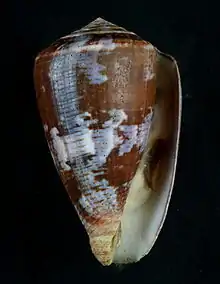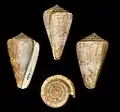Conus purpurascens
Conus purpurascens, common name the purple cone, is a species of sea snail, a marine gastropod mollusk in the family Conidae, the cone snails and their allies.[1]
| Conus purpurascens | |
|---|---|
 | |
| Shell of Conus purpurascens G. B. Sowerby I, 1833, with operculum, measuring 83.7 mm in height, collected at low tide on Venudo Island, in Panama | |
| Scientific classification | |
| Kingdom: | Animalia |
| Phylum: | Mollusca |
| Class: | Gastropoda |
| Subclass: | Caenogastropoda |
| Order: | Neogastropoda |
| Superfamily: | Conoidea |
| Family: | Conidae |
| Genus: | Conus |
| Species: | C. purpurascens |
| Binomial name | |
| Conus purpurascens G. B. Sowerby I, 1833 | |
| Synonyms[1] | |
| |
Like all species within the genus Conus, these snails are predatory and venomous. They are capable of "stinging" humans, therefore live ones should be handled carefully or not at all. Conantokin-P is a toxin derived from the venom of Conus purpurascens.
Description
The size of the shell varies between 33 mm and 80 mm. The shell is broad-shouldered, with a rude, striate spire. It is striate below, and the string sometimes is slightly granular. The shell is clouded with white or violaceous and brown or olive, with close lines of chestnut and white minute articulations. Sometimes it is irregularly white-banded in the middle.[2]
The color variations of this handsome species are dazzling, but the general habit of the shell is quite constant.
(Original description of Conus purpurascens var. rejectus Dall, 1910) This variety has the nebulous brown very pale and scattered in very small patches over a pale purple or bluish ground color. The whole surface in front of the shoulder is rather closely painted with pale brown, thread-like, articulate, spiral lines. The pale lateral band is still notable. The spire is somewhat lower and the shoulder more angular than usual. The spire is ornamented with a few radiating brown flammules, the sutural fasciole is excavated, smooth, or with only one or two obsolete spiral striae.[3]
Distribution
This species occurs in the Central Pacific, off the Galapagos Islands and in the Gulf of California, Mexico.
References
- Conus purpurascens G. B. Sowerby II, 1833. Retrieved through: World Register of Marine Species on 27 March 2010.
- G.W. Tryon (1884) Manual of Conchology, structural and systematic, with illustrations of the species, vol. VI; Philadelphia, Academy of Natural Sciences
- W.H. Dall, Summary of the shells of the genus Conus from the Pacific coast of Americain the U. S. National Museum; Proceedings of the United States National Museum. vol 38 (1910)
- Petit, R. E. (2009). George Brettingham Sowerby, I, II & III: their conchological publications and molluscan taxa. Zootaxa. 2189: 1–218
- Puillandre N., Duda T.F., Meyer C., Olivera B.M. & Bouchet P. (2015). One, four or 100 genera? A new classification of the cone snails. Journal of Molluscan Studies. 81: 1–23
 Conus purpurascens Broderip, W.J., 1833
Conus purpurascens Broderip, W.J., 1833 Conus purpurascens Broderip, W.J., 1833
Conus purpurascens Broderip, W.J., 1833 Conus purpurascens Broderip, W.J., 1833
Conus purpurascens Broderip, W.J., 1833 Conus purpurascens Broderip, W.J., 1833
Conus purpurascens Broderip, W.J., 1833 Holotype of the synonym Conus purpurascens var. rejectus Dall, 1910 in the Smithsonian Institution
Holotype of the synonym Conus purpurascens var. rejectus Dall, 1910 in the Smithsonian Institution
External links
- The Conus Biodiversity website
- Cone Shells - Knights of the Sea
- "Chelyconus purpurascens". Gastropods.com. Retrieved 16 January 2019.
| Wikimedia Commons has media related to Conus purpurascens. |